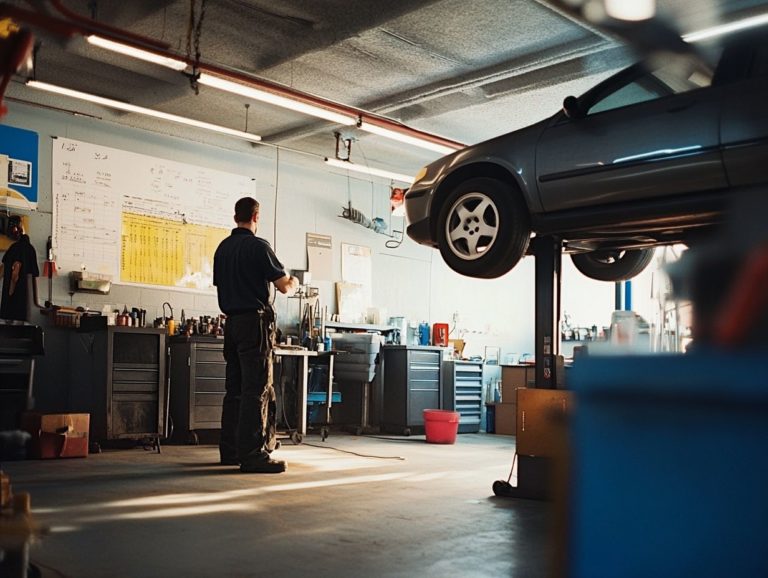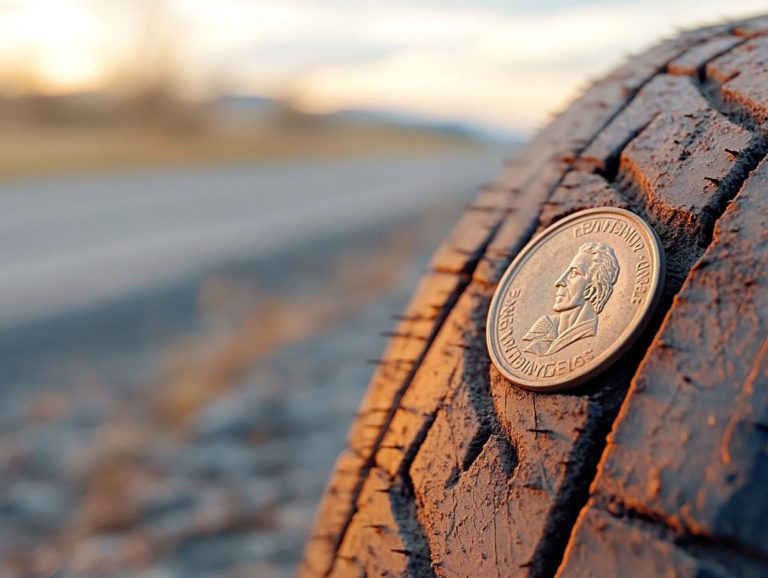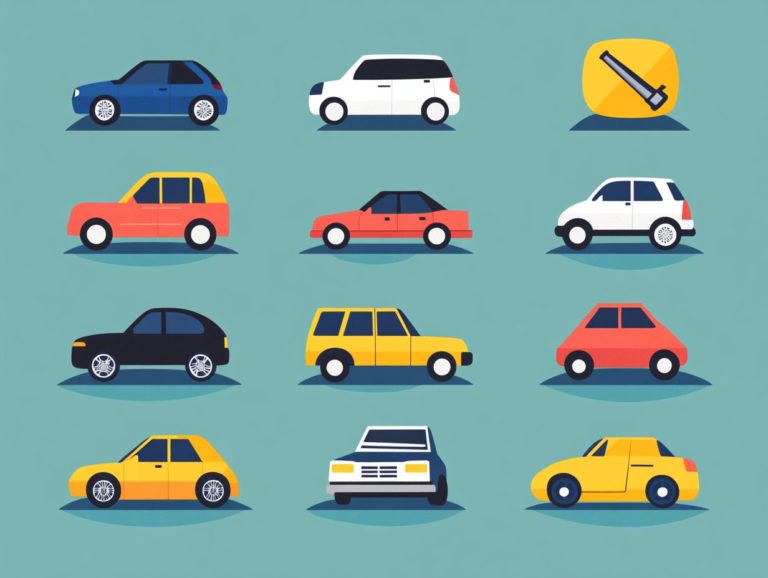Signs That Your Car Needs Brake Replacement?
When it comes to vehicle safety, brakes are essential for ensuring a smooth and secure driving experience. Ignoring the signs that indicate your brakes need replacement can lead to serious risks on the road.
This article will help you identify common indicators, such as warning lights and unusual sounds, while examining factors that contribute to brake wear, including your driving habits. You’ll find guidance on how to check your brakes yourself, a discussion on DIY options versus professional services, and valuable tips for maintaining your brakes to ensure long-lasting performance.
Stay safe and informed your brakes truly deserve your attention!
Contents
- Key Takeaways:
- Why is it Important?
- Common Signs that Your Car Needs Brake Replacement
- Factors that Affect Brake Wear
- How to Check Your Brakes for Replacement
- Replacing Your Brakes
- Maintaining Your Brakes for Longevity
- Tips for Prolonging Brake Life
- Frequently Asked Questions
- 1. What are the most common signs that my car needs brake replacement?
- 2. Why are squeaking or grinding noises while braking a sign of potential brake replacement?
- 3. How can I tell if my brake pads need to be replaced?
- 4. Can I still drive my car if the brake warning light is on?
- 5. Are there any signs of brake replacement that are specific to certain types of brakes?
- 6. How often should I have my brakes inspected for potential replacement?
Key Takeaways:
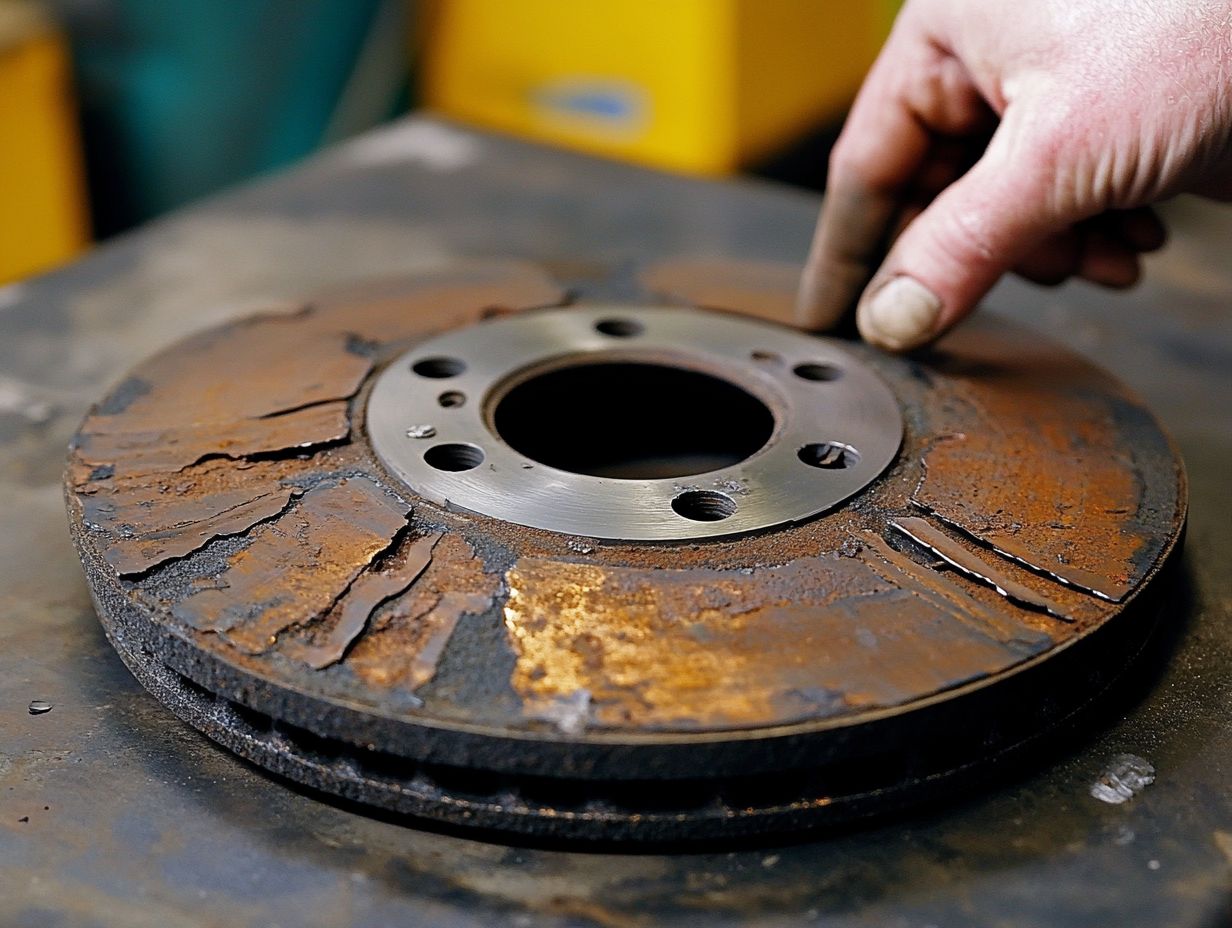
- Listen for warning lights and sounds to detect possible brake issues.
- Watch for changes in braking performance to signal the need for brake replacement.
- Conduct regular visual inspections and testing to determine if your brakes need to be replaced.
Why is it Important?
Understanding how important brake maintenance is can keep you safe on the road! Regular maintenance, including brake inspections and timely replacements, is essential for ensuring that your braking system operates effectively.
This proactive approach not only maintains optimal brake performance but also extends the lifespan of crucial brake components. Being aware of brake indicators and warning lights can help you prevent serious accidents, making it imperative to stay informed about your vehicle’s brake conditions.
Common Signs that Your Car Needs Brake Replacement
Identifying the signs that indicate your car needs brake replacement is essential for ensuring both safety and optimal performance. One obvious warning is a grinding noise when worn brake pads meet the rotors; this is your cue to take action immediately. For more details on car care, check out the signs your car needs immediate maintenance.
Pay attention to any changes in the brake pedal feel; if it feels unusually soft or hard, that could signal deeper issues. Other red flags include illuminated brake warning lights and strange noises while braking.
By recognizing these early signs, you can avoid costly repairs and maintain the reliable braking performance your vehicle deserves.
Warning Lights and Sounds
Warning lights and sounds act as essential indicators of potential issues within your braking system, alerting you to the maintenance your vehicle may need. The brake warning light on your dashboard is often the first sign that something might be off with your brake components; it s a signal that should never be ignored.
If you hear unusual noises like squealing or grinding when you brake, it could indicate worn brake pads or other pressing issues that require your immediate attention. Being attuned to these auditory and visual cues significantly enhances your awareness of your vehicle s braking conditions.
The importance of these indicators cannot be overstated; they can help you avoid more severe complications, such as brake failure, which could lead to hazardous situations on the road. When your brake pads wear down, they can affect the rotors, causing uneven wear or overheating, which can further compromise braking efficiency.
By staying vigilant for these warning signals, you can ensure timely inspections or replacements of brake components, ultimately enhancing not only your vehicle s safety but also its longevity on the road. Regularly monitoring these sounds and lights is vital for maintaining optimal brake performance and ensuring a peaceful driving experience in any conditions.
Changes in Braking Performance
Changes in braking performance can reveal themselves in various ways, such as noticeable loss of stopping power, vibrations, or even your car shaking during stops. These symptoms could point to underlying issues within the braking system, like worn brake pads or warped rotors.
If you notice a dip in braking power or experience a delayed response when you press the brake pedal, it s crucial to have your brakes inspected without delay.
Addressing these changes promptly enhances vehicle safety and extends the lifespan of vital brake components.
A spongy brake pedal? That can signal air trapped in the brake lines or a leak, making it imperative to give it immediate attention. Ignoring these warning signs may compromise your braking efficiency and potentially drive up repair costs over time.
If you feel vibrations through the steering wheel while braking, that could indicate misaligned or unbalanced wheels, complicating your vehicle’s handling further.
Regular maintenance checks can help you identify these issues early, ensuring that your braking system operates at its best and keeping both you and your passengers safe on the road.
Factors that Affect Brake Wear

Several factors can profoundly affect brake wear, underscoring the importance for car owners to remain vigilant about their driving habits and adhere to regular brake maintenance.
Engaging in aggressive driving, frequent stops, and navigating hilly terrains can hasten the degradation of brake pads and rotors, often resulting in the need for premature replacements. Environmental conditions like wet or sandy roads also play a significant role in influencing brake performance and lifespan.
Understanding these factors helps keep your brakes in great shape and ensures that your vehicle s braking system operates at its peak effectiveness.
Driving Habits and Road Conditions
Driving habits and road conditions play a crucial role in the wear and tear of your vehicle’s braking system, directly affecting both safety and maintenance costs. For instance, frequent hard braking and rapid acceleration can lead to quicker brake wear. Navigating steep hills or congested traffic can amplify the problem.
Being aware of these factors enables you to take a more proactive stance on brake maintenance. Regular inspections and timely replacements of brake pads and rotors are vital for ensuring optimal performance.
It’s equally important to recognize the signs of brake wear such as squeaking noises or a pulsating brake pedal as these could signal the need for immediate attention. By blending mindful driving habits with routine checks, you can extend the lifespan of your braking system, ultimately resulting in safer driving experiences and lower repair costs.
How to Check Your Brakes for Replacement
Regular brake inspections keep you safe on the road. Conducting a thorough brake inspection is essential for determining when brake replacement is necessary and ensuring your overall vehicle safety.
A comprehensive visual inspection can unveil worn brake pads, cracked rotors, and other critical components that might require your attention.
You should perform brake diagnostics and testing to gain valuable insights into the performance and condition of your brake system.
Recognizing the signs of wear or damage during these checks is vital for maintaining your brakes effectively and promptly.
Visual Inspection and Testing
A visual inspection is an essential first step in assessing the condition of your vehicle’s brake parts. This step allows you to spot issues that could lead to potential failures. Look for signs of wear on the brake pads, check for discoloration on the brake rotors, and watch for any leaks in the brake fluid.
Evaluating the condition of the brake calipers and lines is equally critical. These parts are vital for optimal performance. Keep a close eye on your brake fluid levels. Insufficient fluid can seriously compromise your braking power.
Combining visual inspections with thorough performance testing helps you accurately assess how your brake systems react in real-world conditions. This can identify any discrepancies in stopping distances. Prioritizing these procedures enhances your vehicle’s safety and extends the lifespan of your brake parts for a more reliable driving experience.
Replacing Your Brakes
It s time to replace your brakes. Understanding the differences between DIY approaches and professional brake services is essential for your safety and your wallet.
As a car owner, don’t wait if you’re up for the challenge, tackling your brake replacement could save you money! If you have the necessary tools and expertise, you might consider replacing brake pads and rotors yourself. However, enlisting the help of skilled brake technicians or a qualified mechanic can guarantee flawless work.
Know when to call in the pros for a quick fix that keeps you safe! This can save you time and significantly enhance the overall effectiveness of your braking system.
DIY vs Professional Services
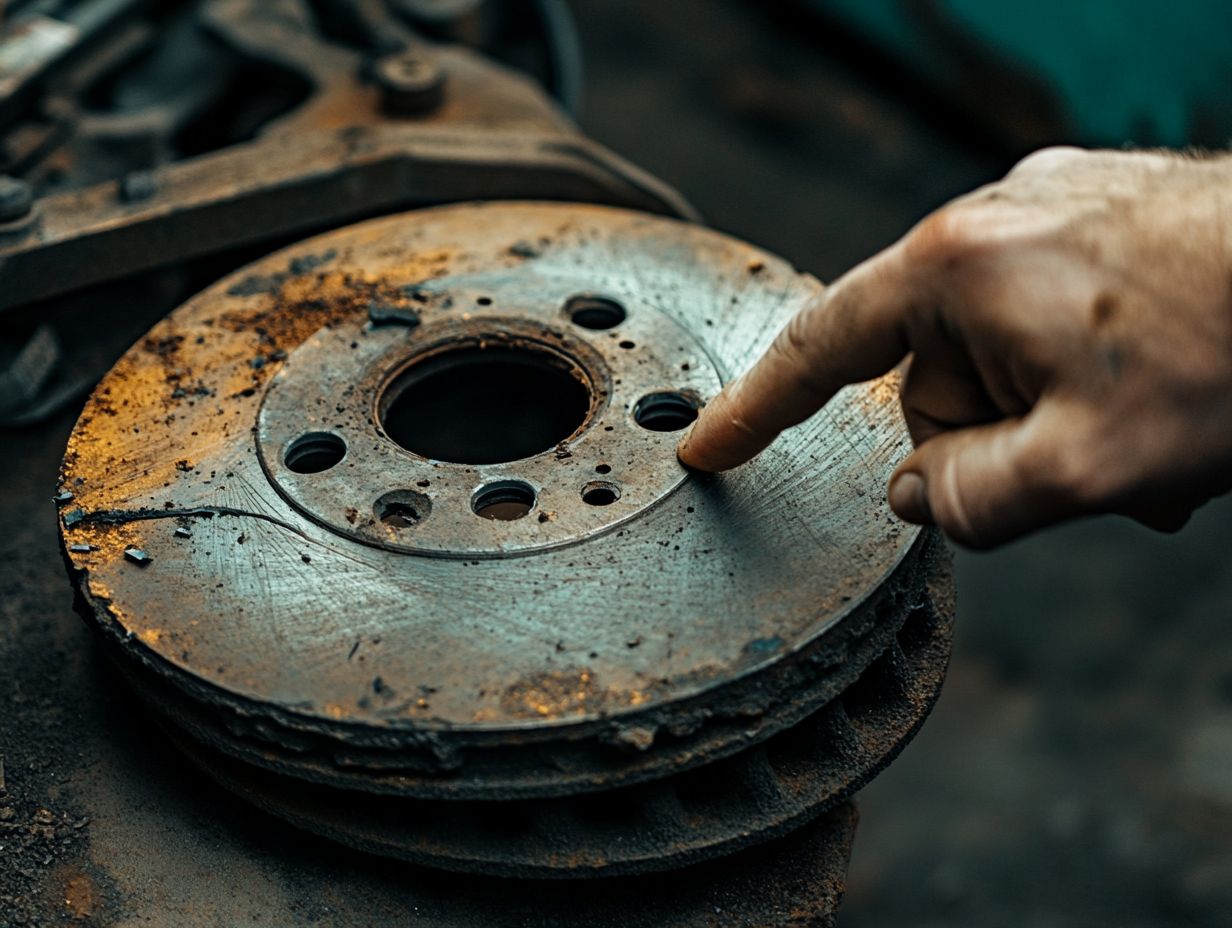
Choosing between DIY brake replacement and professional brake services requires thoughtful assessment of your skills, tools, and the complexity of the task. While taking the DIY route may save you cash if you have experience, it also carries risks; a poorly executed job could lead to brake failure.
On the flip side, opting for professional brake services means entrusting the job to skilled mechanics. This can provide invaluable peace of mind and assurance regarding your safety. Knowing when to call in the pros is crucial for maintaining your brakes at peak performance.
You might feel confident in your ability to tackle this task, especially with countless online tutorials and videos at your fingertips. However, not everyone possesses the necessary mechanical skills or the right equipment, which can significantly impact the outcome of your DIY project.
Don’t underestimate the time commitment involved; what seems like a straightforward task can quickly become complicated, particularly if unexpected issues arise. Ultimately, weigh factors such as your budget, personal expertise, and the current condition of your vehicle to make an informed decision that balances cost savings and safety.
Maintaining Your Brakes for Longevity
To ensure the longevity of your braking system, adopting effective brake maintenance tips is essential. Regular inspections, timely replacements, and proper driving habits can extend the lifespan of your brake parts while maintaining optimal performance.
Keep an eye on brake dust accumulation and ensure adequate brake fluid levels to contribute to the overall health of your braking system. Implementing these strategies enhances safety and reduces the likelihood of costly brake repairs down the line.
Ready to take care of your brakes? Schedule a professional inspection today!
Tips for Prolonging Brake Life
Implementing effective strategies for prolonging brake life can elevate brake quality, efficiency, and the overall safety of your vehicle. Regular maintenance is key schedule inspections, select high-quality brake pads and rotors, and drive smoothly to significantly reduce wear and tear.
Watch for uneven wear signs like vibrations or pulling during braking. This may indicate misalignment or other issues within the brake system. Ensuring that your tires are properly inflated and rotated plays a crucial role in achieving even braking performance.
A smooth approach to braking gradually reducing speed rather than abruptly hitting the brakes will help alleviate stress on your braking components.
By integrating these strategies into your routine maintenance, you re not only extending the life of your brakes but also fostering a safer driving experience for everyone on the road.
Frequently Asked Questions
1. What are the most common signs that my car needs brake replacement?
Common signs that your car needs brake replacement include squeaking or grinding noises when applying the brakes, a vibrating or pulsating brake pedal, longer stopping distances, and a dashboard warning light for the brakes. For more detailed information, check out common signs of brake wear.
2. Why are squeaking or grinding noises while braking a sign of potential brake replacement?
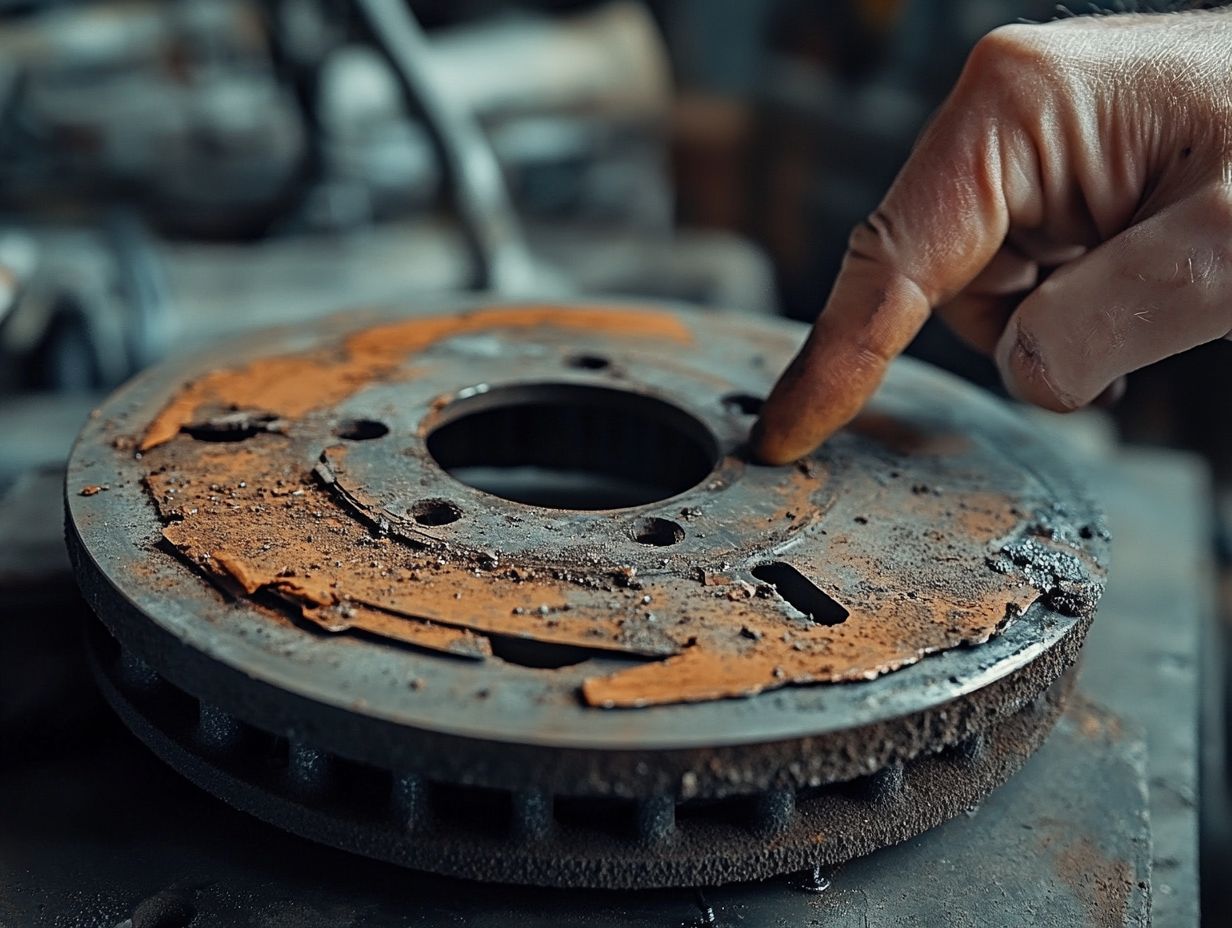
Squeaking or grinding noises are often caused by worn brake pads, which can lead to metal-to-metal contact between the brake rotor and caliper. This can cause further damage and decrease the effectiveness of your brakes. Don’t wait! Replace them quickly to stay safe on the road!
3. How can I tell if my brake pads need to be replaced?
You can check the thickness of your brake pads by visually inspecting them through the wheel spokes. If they appear to be less than a quarter of an inch thick, they should be replaced. You can also have a mechanic check them during a routine maintenance check.
4. Can I still drive my car if the brake warning light is on?
No, it is not recommended to drive with the brake warning light on. This light indicates a problem with your brakes, and it s crucial to have them inspected and potentially replaced as soon as possible to ensure safe driving.
5. Are there any signs of brake replacement that are specific to certain types of brakes?
Yes, for example, if you have disc brakes, you may notice a pulsating or vibrating sensation when braking. If you have drum brakes, you may hear a clicking noise when braking. These are signs that your brakes may need to be replaced.
6. How often should I have my brakes inspected for potential replacement?
It is recommended to have your brakes inspected at least once a year or every 12,000 miles. However, if you notice any of the signs mentioned above, it s essential to have them checked as soon as possible to prevent potential accidents and further damage to your vehicle.


